» Home
» About
» Membership
» Journal
» Sparoza Garden
» Branches
» MGS Forum
» Seed Exchange
» Donations
» MGS Excursions
» Information
» Members' Gardens
» Book Reviews
» News & Views
» Contact
» Search
BRANCH HEAD

Christina Lambert
Information and
resources for Greece
Ελληνικό ιστότοπος του MGS
|
The Greek Branch of the MGS
Past Events 2017 2016 2015 2014 2012 Older
December 2013
Following an Ancient Road
On Sunday December 15, 2013, a group of MGS members set off in the footsteps of the ancient Greeks. The ancient road called Sfittia odos ran from Thorikos (near modern-day Lavrion) to Athens, passed through Keratea and Kalyvia, which is now the modern town of Koropi, past the ancient town of Sfittos, up the slopes of Mount Hymettus, and by way of the saddle between Mount Profitis Elias and Mount Mavrovouni, down the other side to Glyfada and along the coast to Athens.
The part of the route that was a track over the mountain was in use until the 1950s by farmers carrying their produce to the Athens markets by donkey, but in more recent times it had become overgrown and difficult to navigate.
Recently, the municipality of Koropi hired a young path-maker, Fivos Tsaravopoulos, to clear a stretch of the track in order to give nature lovers and hikers better access to the beauty of their mountainside. You can read more about his work on his website.
We gathered by the roadside at about 10 a.m., and piling into as few cars as possible, we followed our intrepid leaders up a dirt track and around the large pile of dirt and plastic that used to be the Koropi rubbish tip. We were happy to hear this is no longer used and is being properly restored. It will become a new hill, planted with shrubs to blend in with the countryside.
After a bit of trouble tracking down some lost MGS members, we all gathered at the start of the path and began to make our way up the mountainside.
Accompanying our group were Professor Spyros Lekkas, a geologist and seasoned mountaineer, and Professor Aris Tsaravopoulos, an archaeologist with years of experience exploring the Greek countryside for interesting traces of the past. Their combined knowledge furnished us with many fascinating titbits of information as we climbed uphill, keeping our eyes open for winter bulbs and flowering shrubs. When we stopped and turned around to look at the view, the beauty of our surroundings enthralled us.

The view
(Photo by Frosso Vassiliades)
Stopping at an ancient well (Pigadi Doukas) tucked into the ravine by the side of the path, we learned that the water came only from the seasonal rain, as Mount Hymettus has no springs. In fact, the well was really a reservoir dug into the non-permeable rock in that location. If it had been dug any deeper, the water would have drained away as the diggers would have struck the permeable limestone below. Obviously, the ancients knew what they were doing.
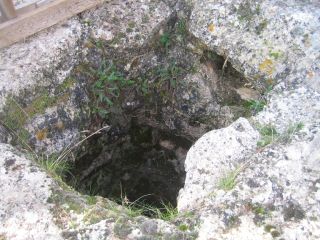
Doukas well
(Photo by Frosso Vassiliades)
After about half an hour of uphill walking, we reached the pass called Stavros, and we were able to look over to the other side towards Terpsithea, Glyfada and the ancient way to Athens.
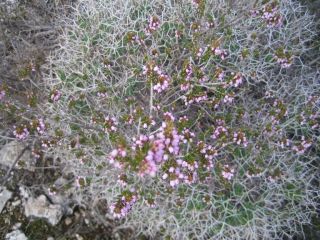
Erica manipuliflora
(Photo by Frosso Vassiliades)

Crocus laevigatus
(Photo by Nikos Lymperopoulos)
Nearby were clear traces of the foundations of what may have been a 4th-century BC military watchtower. Several similar towers existed along the coasts of Attica to transmit signals to the Acropolis.
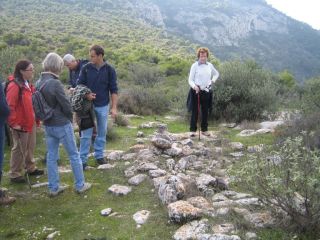
Ruined watch tower
(Photo by Frosso Vassiliades)
After a short rest, we took a path to the south, passing alongside the hill and up a steep, newly created path to Tripia Spilia. When the roof of this large cave collapsed, a bridge of rock remained over the entrance, so there is a big hole in the roof. Intrepid climbers like to walk over the bridge, but none of us attempted this, although some scrambled over boulders into the depths of the cave. On the walls, stalactites from when the cave was still underground were visible.
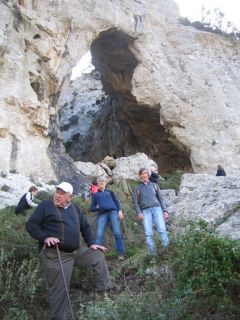
Tripia Spilia
(Photo by Frosso Vassiliades)
From here you can follow a path down to Glyfada, but we retraced our steps back to Koropi and a delicious lunch at a new taverna called Agora.
This path has already attracted some new hikers to Koropi, so congratulations to everyone involved in its making.
Text by Frosso Vassiliades
November 2013
The Greek Branch hosts the 19th AGM in Attica
With torrential rains making this November the wettest in years, we were extremely lucky that glorious sunshine and warm temperatures blessed our days in the Athens area. Those who went to on the optional trip to the Peloponnese afterwards were not so fortunate, but good company and good food, not to mention good wine, made up for two-and-a-half days of monsoon.
A gala inaugural buffet dinner launched the events after registration at the Goulandris Museum of Natural History in Kifissia. It was held in the basement’s attractive mineral exhibition area, where fossils and precious ores decorated the walls. The rooms buzzed with happy talk as old friends recognized each other and as new connections were made. The food was delectable – one could call it creative Greek traditional.
On the morning of day two, we split up into two groups, one choosing a walk in Parnitha, the other a tour of the little-visited site of Eleusis. The Parnitha group was surprised to see that the burned area between the Casino and the Bafi Refuge still looked barren, especially in view of the fact that the fire occurred in 2007. After arriving at the refuge, we were taken on a walk in surviving forest land, accompanied by a band of charming and knowledgeable guides from Trekking Hellas. There weren’t many flowers to see, but the views were stunning, the weather amazing and our guides delightful, so we had a wonderful time. After the walk the bus took us back to the refuge, where botanist/biologist Tikki Athanasiou gave us a slide show on the flora and fauna of Parnitha. This was followed by an appropriately rustic lunch – a choice of the traditional bean soup or vegetable soup with salads and other mezedes.
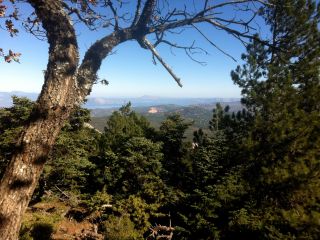
Parnitha
Photo by George Brumder
Two excellent guides initiated the second group into the mysteries of Eleusis – at least the gist of what went on there in commemoration of Demeter’s loss of Persephone. We know that its message concerned the afterlife and rebirth, and, fittingly, both the site and the industrial suburb of Elefsina that surrounds it have undergone a renaissance. Pedestrianised cobbled streets, plantings and restored neoclassical buildings have transformed this formerly sooty, dusty place, making it a treat all the more delightful for being unexpected. Many guests seemed pleased to be introduced to the famous place, saying they ‘never would have thought of coming’ on their own.
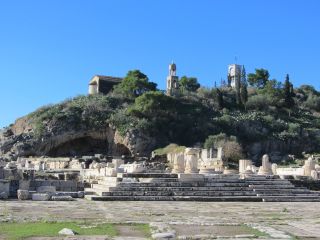
View of Eleusis from the entrance, with Pluto’s cave at the back left
Photo by Diana Farr Louis
That afternoon we were allowed a short nap before departing for Athens and a visit to the new Acropolis Museum. Here too our guides were so enthusiastic that they held our interest – no mean trick – for the whole visit. From there, we repaired to the Strophi taverna nearby, which has an enclosed roof terrace with a fine view of the Parthenon, all lit up.
On day three, bright and early, we set out from Kifissia to visit Sparoza and two members’ gardens in the vicinity. The first of these two gardens, in Keratea, can be considered a work in progress, an experimental, drought-tolerant garden, as the owners and the designers Jennifer Gay and Piers Goldson wish to see just how much water plants can be denied and still thrive. All shrubs and perennials are sourced from Olivier Filippi’s nursery in the south of France, so it was an added pleasure to have him and his wife with us, as well as Jennifer and Piers, who explained the philosophy as well as such innovations as gravel beds to provide good drainage and cut down on weeds. For local members who would like to see this wonderful garden, which fits so well into its phrygana surroundings, we are planning a visit in the spring.
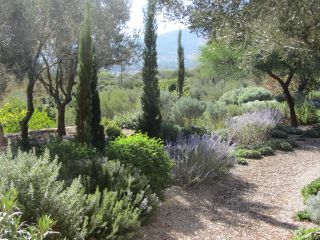
Plants from Filippi’s nursery thriving in gravel beds
and blending nicely with the native phrygana
Photo by Diana Farr Louis
After a copious, but healthy – mostly vegetables and salad – lunch at the Elaionas taverna near Sparoza, we boarded our buses and both groups descended on the magnificent garden on a southern slope of Mount Pendeli. As the owner explained, her 8.5-acre garden was begun 22 years ago, on a scale rare in Greece. Stately and formal, with many ‘built’ features, such as monumental staircases, fountains and pools, it was designed by the gifted American landscape architect Charles Shoup. But the profuse planting and carefully used grass ‘softens’ the stonework, which also divides the garden into smaller or larger areas, each with its own atmosphere. Because of the recent need to cut expenses, the owner felt that ‘it lacks the detail that makes a place truly special and many beloved treasures have been lost’. That said, it still looked very special to us and the owner has plans to make it more productive, cultivating the existing fruit and olive trees and expanding the vegetable and herb garden.
Both hostesses offered us sublime refreshments – home-made cakes and biscuits, juices and coffee/tea.
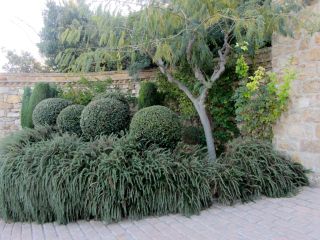
Rosemary of various types was a recurring theme in the formal garden
Photo by Diana Farr Louis
On the morning of day four we all met again at the Goulandris Museum for the General Assembly, and then again in the afternoon to hear our keynote speaker, Olivier Filippi, tell us about ‘Alternatives to lawns’. A born story teller/actor as well as plant collector, nursery owner and expert in waterwise gardening, Filippi drew a full house and had our full attention, hooking us from the first slide with an account of a trip to Sounion with his wife. We saw the famous temple and the plants around it with his eyes and then explored a bit further where something green gleamed brightly against the sea and bare rocks. He teased us and kept us in suspense while he slowly revealed his find: not a lawn, but a magnificent expanse of emerald plastic. No maintenance, no watering, it was definitely an alternative but not among those he had in mind.
What followed were slides of ten of his ideas, which included grasses, groundcovers like thyme and even a mix of ‘weeds’, steps and steppes, gravel, pavement/flagstones, phrygana and mediterranean meadow. He also showed how to divide our gardens into hydrozones of varying degrees of watering, and explained the pros and cons of different approaches. A full account of his talk will be available on this website.
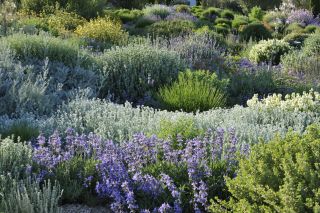
One of Olivier Filippi’s alternatives to a lawn
Photo by Olivier Filippi
Exhilarated and full of enthusiasm, we walked from the Museum to the final dinner at the Semiramis Hotel nearby. There amid toasts to Alisdair Aird, our new president, Jean Vaché, our outgoing president, and many others who contributed to making the AGM such a success, we ended the festivities on a note of optimism and co-operation for the new Administrative Committee.
Optional trip to Messinia
It was already overcast when some fifty of us left Kifissia on the morning of day five, drizzling by the Corinth canal, pouring cats, dogs, chairs and tables by the time we pulled up to the Semeli winery in Nemea (in Greek ‘raining cats and dogs’ is described as ‘raining chair legs’). So heavy was the rain that we could not see the ‘Tuscan’ beauty of the rolling, vine-covered hills and thick stands of cypresses through our fogged bus windows. And although we were indoors, we did not get more than a hazy image of the scale and technology of this ultra-modern winery. However, the tasting sessions were a tremendous success and more wines accompanied a fine lunch in their spacious dining room. So, by the time we re-joined our bus, most of us were either too sleepy or too bubbly to mind getting stuck on one of Nemea’s spaghetti-thin roads, where cars and pickups were parked higgledy-piggledy by locals rushing to a funeral.
Finally, after a wait of more than an hour, we set off again into the dusk and much later reached our destination, the Costa Navarino resort at Pylos that in just three short years since its opening has won dozens of awards and hundreds of rave reviews. Able to sleep 1500 people, it employs 1000 and has brought employment to another 2000 in the Messinia area. It is also pledged to high eco standards and we were impressed to learn, when the rain eventually paused on Tuesday afternoon, that the complex irrigates its grounds and golf courses primarily with its own reservoirs and recycled water, that almost all foods prepared in its kitchens are locally sourced, and most of the plants on the 2,500-acre estate are from the Mediterranean. They are also justly famous for their programme to save the venerable olive and citrus trees that were on site before construction began. Of the 6,000 olive trees that were dug up, kept in ‘transit’ and replanted, only four have died. Of course, there are lawns, and some of us wondered whether the olives that were replanted in their midst would be compatible with the watering and fertilizers needed to keep the grass green.
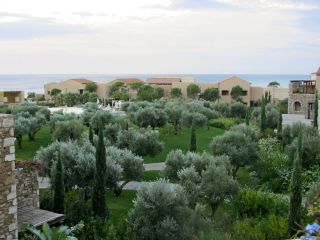
A view of the Costa Navarino grounds
Photo by Diana Farr Louis
Next morning, with the rain still pelting down, we were magically consoled with a slide show/talk by Andrea Bonetti, an Italian-Swiss biologist-photographer who has spent years in the Gialova lagoon near Pylos, but has travelled all over Greece as well. He kept us enthralled with his images and his knowledge, and some of us were reluctant to stop for lunch. You can see some of his work here, and we have invited him to give a similar show to the Greek branch this winter.
Mercifully, the rain petered out, the sun glimmered from behind the grey and we had a pleasant stroll round Pylos town, lunch, and then a guided walk through the wetlands of Gialova, with Bonetti showing us distant flamingos with his giant telescope, as we admired hardy, pink marsh grasses and lichen-covered shrubs. The tour of the hotel grounds followed and then we crowded into the Natura Hall, an interactive, educational display of photographs (many by Bonetti) and ecofacts, primarily designed for young people but interesting to adults as well.
Our sojourn over, we piled into the bus again on the morning of day seven, looking forward to a tour of Ancient Messene on our way back. The city, founded in 369 BC by the Theban general Epaminondas as a buffer against Sparta, has only recently been excavated, and new buildings come to light regularly. Alas, the rain god was travelling in the same direction, so we only managed to see the small museum and had a brief walk with umbrellas to survey the ancient theatre, which is so well preserved that performances took place there last summer. Again our guides were exemplary.
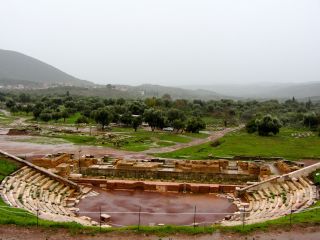
The theatre of Ancient Messene in the rain
Photo by Diana Farr Louis
Lunch at the Ithome taverna restored our spirits and our ride to Athens was uneventful. We may not have seen as much nature and horticulture as was intended, but we cemented relationships and enjoyed ourselves thoroughly. For this, an enormous amount of credit is due to Katie Papadimitriou, director of Symvoli Conference and Cultural Management, who was constantly on the phone re-arranging our schedule and shepherding us with grace and humour, and to our heroic driver Yiannis, who never stopped smiling as he steered us in awful conditions to our destinations. Credit is also due to our resilient members, who were appreciative of everything we did manage to see and kept their kefi or spirits high.
Diana Farr Louis and Frosso Vassiliades
October 2013
Visit to Theologos and the ancient site of Halai
When you schedule a botanical trip in mid-October in Greece, there’s always a risk that plant life will be minimal to non-existent owing to a delay in the autumn rains. And that was exactly the fate of our visit to Theologos, a village in Fthiotida on the gulf of Evia, where MGS members Laura Purdy and John Coleman have been living and gardening for half the year since the late 1980s. John, Professor Emeritus of Classics at Cornell University, has been responsible for the excavations at the Neolithic/Greco-Roman site of Halai there for almost 20 years.
So, despite the lack of horticulture, we had an insider’s guide to the site, followed by a pleasant walk in the nearby pinewoods and a delectable lunch at a seaside taverna. After a marvellous welcome with ‘the best bougatsa in the region’ ordered specially for us, we walked the few metres to the antiquities. A wonderful speaker, John made us see the area as it would have been, first in 6000 BC, when the earliest settlers lived there, and later from 600 BC to AD 600, when there were three more periods of occupancy.
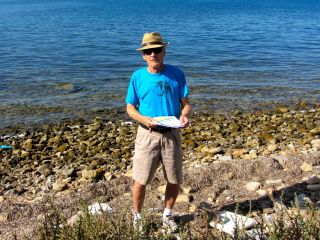
John Coleman by the rising sea - much of ancient Halai is under water now
The gulf, which looks so placid and stable, was (and is still) in constant movement. With a fault line running parallel to the National Road, earthquakes have occurred frequently, causing the water level to rise 120 metres in 5000 years and push Evia away from the mainland. As the sea rushed in, the gulf deepened, creating one of the most important shipping lanes in ancient Greece, with perhaps 300 ships a day plying the straits. Fortifications and small towns sprang up at close intervals to protect the ships and benefit from the trade. Halai’s salt flats – covered now – were a source of wealth, used to preserve the abundant fish that formed a major dietary staple.
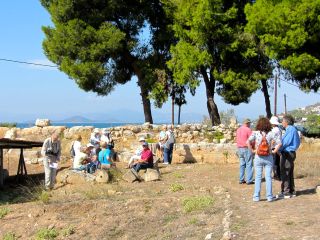
Plenty of remnants of ancient walls, but not an autumn flower to be seen
As for the site, there are no temples or glorious marbles to delight the photographer, but John pointed out the different layers of Neolithic settlements, an Archaic altar, a Hellenistic gate and an Early Christian basilica, boosting our imaginations with diagrams of the site at various periods and colour photos of the pottery, figurines, mosaics and other finds. We also received a mini lesson in paleobotany, learning what plants those earliest inhabitants dined on: emmer wheat and einkorn, barley, lentils and vetch, figs, pistachios, pomegranates and wild grapes, plus tuna, and meat from the usual cloven-hoofed animals.
With the sea level still rising – parts of the site are only 90 cm above the water – and the coast road only two metres away, the challenge now is to preserve as much as possible. There are no easy solutions and we thought back to the days when the Halai excavations were begun in 1911, by two of the first women archaeologists to work in Greece, Alice Walker-Cosmopoulos and Hetty Goldman, whose father was an investment banker. We wondered whether Goldman-Sachs could help in any way for old times’ sake.
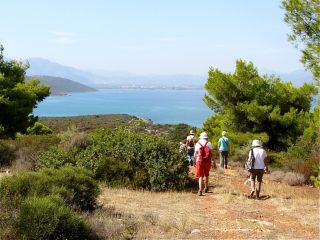
Beautiful views and companionable exercise but very little new growth
Having explored the bare site, we longed for a walk and Laura led us to a hillside on the opposite side of the bay, which in a wetter October would have been dotted with crocuses and cyclamen. We had to content ourselves with gorgeous views and pine trees, until the very end, when someone stumbled upon a tiny clump of our favourite pink flowers.
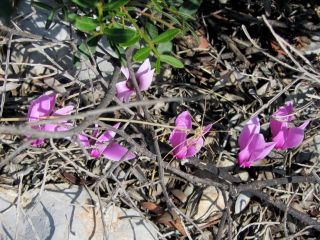
Our only cyclamen
What was lacking in botany, we more than made up for in camaraderie, good talk, free-flowing wine and delicious food. And for dessert, we polished off that memorable bougatsa.
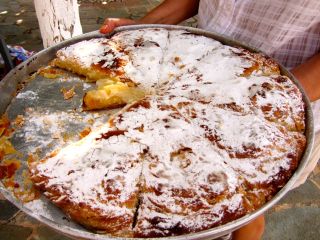
The ethereal bougatsa that began and ended a lovely outing
Text and photographs by Diana Farr Louis
May 2013
Three gardens in Kifissia
So close and yet so different, all three gardens were wonderful examples of MGS principles, using (mostly) local plants, little water and a flexible approach to nature or what some might call weeds.
The first garden represented Old Kifissia – a listed house built in 1910, containing towering cypresses and other trees that pre-dated it by 50 years. But when the owners bought the property in 2001, they wanted to do away with its expanse of lawn and turn it into a Greek garden. RK, who happens to be a civil engineer, craved structure and commissioned Marina Adams, MGS member and well known landscape architect, to come up with solutions. A path, lined with a ‘fluffy’ rosemary hedge (Rosmarinus officinalis ‘Punta di Canelle’) on one side and lavender (Lavandula angustifolia) on the other, led to the former lawn.

The entrance to RK's garden. Rosemary and lavender border the path.
Photo by Diana Farr Louis
This open space was fascinating as a partially successful experiment. As R told us, ‘We planted it with seven types of creeping thymes: Thymus roegneri (syn. T. hirsutus), T. mastichina (syn. T. ciliates), T. serpyllum, T. linearis var. album (syn. T. serpyllum var. albus), T. ‘Lemon Curd’, T. herba-barona, Thymbra capitata (syn.Thymus capitatus), and Frankenia laevis, but if I had to do it all over again, I would only plant the last one. Frankenia laevis is an alternative tothyme, doesn’t dry out and in winter it has a pretty reddish-brown colour. Because these varieties were difficult to find here, we ordered them from Olivier Filippi’s nursery in France. To avoid weeds creeping in, we placed a glass-fleece under the soil, then punctured it with holes for 2000 pots and topped it with gravel. This proved to be a problem, as the thyme couldn’t spread freely and nature rushed in to fill the gaps - she doesn’t take to utopian idealism and regimentation. Ironically, the most successful ground cover is the Phyla nodiflora (syn. Lippia nodiflora) patch nearer the house; it grows so densely that the weeds don’t get through, and it makes a soft pink carpet in spring even though we pay practically no attention to it.’
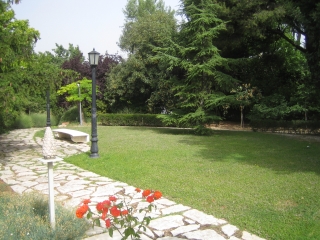
A thyme lawn as an alternative to grass
Photo by Frosso Vassiliades
Between the white house and the thyme lawn, Marina had planted Rosa ‘Glamis Castle’and Rosa banksiae (common name baxevanis in Greece) in creams and whites, to repeat the pale colours of the house. Next to them stood a dwarf ginkgo on steroids, and next we passed under a grape/wisteria arbour to get to the vegetable patches. There were several patches, arranged south and east of the boundary wall, in every stage of growth from tomato seedlings to red-fruited fraises des bois to bolting cavolo nero (Tuscan kale), plus a bed with lilacs and other flowering shrubs (Philadelphus coronarius, Phlomis italica) used exclusively for cutting. Fruit trees for all seasons stood here and there, while in the front of the house was an empty area where R told us she grows horta (greens) from her native island of Crete that she collects all winter.
We were in awe of the careful thought that had gone into this garden and thrilled to find a space so atypical and productive so close to the central shopping district. There was even an area covered by Jaborosa integrifola, which helps stabilize the soil in steep corners of the plot.

Jaborosa integrifolia
Photo by Frosso Vassiliades)
The next garden, owned by LK, a Sparoza volunteer, higher up and close to where Kifissia ends and Mount Pendeli begins, was more similar in spirit and soil to Sparoza. The garden consisted of a very gentle slope under tall pine trees, sculpted into terraces with stones by Kyrios Thomas, the ‘artist’ gardener. Like our first hostess, L did not want a lawn, but what would grow under the pines? To start with, we found an acanthus border that would be green for a few more weeks at most, standing next to plenty of pink-flowered gaura, which flowers all year. There was tradescantia, whose pink blooms last all summer, cistus, and plenty of the usual suspects – rosemaries, lavenders, silver-leaved artemisia lookalikes, various species of iris, salvias, yellow-blossomed Bulbine frutescens, a member of the asphodel family – and many more native plants (Myrtus communis, rhamnus, arbutus, Laurus nobilis), that made for a varied mix of creepers, bushes and trees that was very restful to the eye.
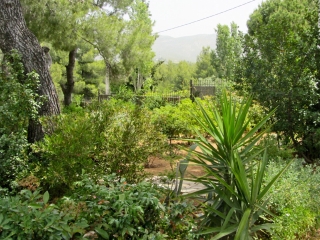
LK's garden with a hazy Mount Pendeli in the background
Photo by Diana Farr Louis
L explained that five years ago, MGS member and garden designer Jennifer Gay had come in like an ‘angel’ and made a path to join the various areas in the garden as well as an oval patio. At the same time, the pines had become a disaster, full of cottony fluff and all but succumbing to the panhellenic plague induced by the pine pest Marchalina hellenica. Wrapping the trunks in plastic tape to keep the insects away and washing them with organic mineral soap eventually produced results, and the trees looked healthy again.
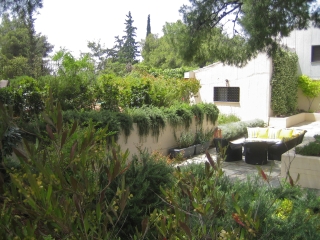
Rosemary tumbles over the wall into a seating area in L’s garden
Photo by Frosso Vassiliades
L spoke movingly about how her work at Sparoza as a volunteer has formed her ideas about gardening: ‘Everything you see here is due to Sparoza, and especially to Sally Razelou. I try to have a waterwise garden, with plants mainly native to Kifissia, but I also experiment with plants from other mediterranean countries.’
We left in a cloud of thyme and oregano, ground-huggers that spill on to the path from the gate into the garden proper.
While L’s garden seemed an idealized extension of an Attica hillside, NC’s garden, just a few blocks away, was almost a jungle. Entering it through a ‘hole in a wall’, many guests were heard to exclaim, ‘Why, this is a secret garden!’ Again we saw acanthus, leafy and floppy this time, rather than erect, and Bulbine frutescens, with orange rather than yellow blooms, irises and bright yellow phlomis, but the effect was very different. Tall trees provided so much shade one wondered whether the sun ever penetrated, but all the plants looked happy and certainly not starved for light. Rambling roses looped around some of the branches, but all that was left of the April peonies was their leaves. Much of our attention focused on the presence of two lily ponds.
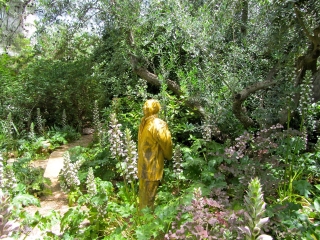
In NC's garden, statuary is hidden in the 'jungle' of acanthus
Photo by Diana Farr Louis
N said that the garden was transformed when the lily ponds were added as a new, damper microclimate was created. As she told us, ‘The trees and shrubs benefited from the additional moisture in the atmosphere. From then on, the garden, not the gardener, took the upper hand; many new plants appeared on their own, some naturalized and became seasonal familiars like the masses of borage in March and the acanthus in May, while some needed coaxing and begging like the peonies. Overall, this is a garden where nature works much harder than the gardener.’
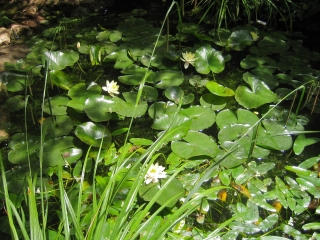
The lily pond
Photo by Frosso Vassiliades
N’s garden had a playful atmosphere, contributed to by small solar-powered yellow and orange lanterns near the ponds and dangling from the trees, and by the surprise of coming across pieces of sculpture half hidden in the greenery. Of course, tadpoles, goldfish and glowing water-lilies bring smiles even to grown-up faces. Another star was her elder tree (Sambucus nigra), from whose flowers N had made wine for our delectation.
Each garden was very special, with intimate corners for sitting alone and larger spaces for company, and each hostess treated us intruders with the hospitality for which Greece is famous. We were thoroughly spoiled.
Diana Farr Louis
April 2013
Visit to northern Evia
This year’s three-day trip took us to the northern part of Greece’s second largest island, Evia (ancient Euboea), an area with rivers and mountains, waterfalls and thick forests, so green it looked like a travel poster for Switzerland.
Our first stop was Rovies, halfway up the coast opposite the mainland. There we stayed at the Eleonas Agrotourism Hotel, which couldn’t have been more helpful in arranging our walks as well as two superlative taverna meals. Eleonas means olive grove, and in the afternoon we were given a tour of a very small part of the ocean of olive trees viewed from our rooms. Owned by the Papadopoulos family, the property once stretched from Limni in the south and over the mountains to the Noel-Baker estate in the centre of the island, our destination for the following day.
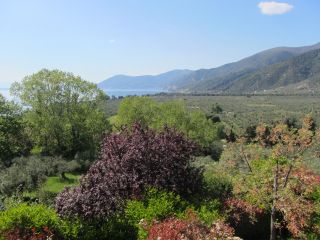
The view of the olive grove from the hotel named after it, Eleonas
Photo by Diana Farr Louis
The ecofriendly Eleonas grove is cleared in strips, leaving ‘corridors’ of uncut ‘weeds’ between the trees which serve as habitats and food sources for insects and birds. They also camouflage the irrigation pipes which carry water from a spring underground. Our guide, Alexandra Valli, cousin of our host, Stephanos Vallis, told us that her grandfather had cleared the dense forest of holm oak (Quercus ilex), kermes oak (Quercus coccifera), Pistacia lentiscus and clinging vines, including winter clematis, and grafted new stock on to the old trees. The olives, most of which are processed for eating, are picked by hand – preferably by women. (Did you know that in ancient times only virgins were allowed to pick from the olive trees near the Acropolis? Their sensitive touch prevented the fruit from bruising.)
After a short detour to view rock samphire (Crithmum maritimum) growing by the sea, we wandered in the grove, more and more amazed at the size and shapes of the trees, no two the same, until we reached Methuselah, the oldest and most stunning of them all.

The largest and oldest tree in the grove, which may possibly date back
to when Strabo described an olive grove at Orobiae in the first century AD
Photo by Diana Farr Louis
The hotel itself has its own cheerful garden – no lawns and palms, as our hostess, Marina Valli, told us. It was originally landscaped and symmetrical, but Stephanos and Marina disobeyed their designer and allowed it to grow wild and merge with the nearby forest. The effect is so charming, with different flowers planted for each season, who could complain? Among other plants, we noticed bamboo, wild gladioli, a giant geranium, sage and Jerusalem sage (Phlomis fruticosa), poppies, alliums, creeping rosemary, fruit trees, a slope full of white African daisies, and a yellow Banksia rose that galloped all over one hillside. In addition, there were lots of poplar trees, for once upon a time they were used in making toothpicks.
The next day, after a gourmet dinner cooked by Stephanos and a breakfast that included home-made breads, jams and kiwi-orange juice, the Vallis led us in convoy up to the Drymonas waterfalls and then on foot to the top of Xiron Oros (Dry Mountain). The falls were suitably dramatic and most of the mountain much greener than its name implies. On the way up the nicely marked path, strategically placed signs identified some of the trees and shrubs, including black pine (Pinus nigra), Greek fir (Abies cephalonica) and other firs, pear, cistus (not yet in bloom), hellebores by the dozen, blue and white Anemone blanda, primrose lookalikes, leopards’ bane (Doronicum orientale), yellow alkanets and an orchid or two. Some of us who knew our limits, stopped at the picnic plateau, but those who reached the summit were rewarded by spectacular views of snow-capped mountains and the Sporades islands. Alas, the peonies that had lured them there were frustratingly just about to pop.
A shot of smooth tsipouro accompanied by one or two dried figs gave us the jolt needed to complete the descent and ignore the complaints of our knees.
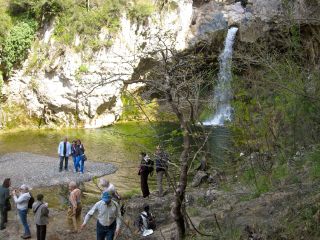
The Drymonas falls half way up Xiron Oros
Photo by Olia Jakovides
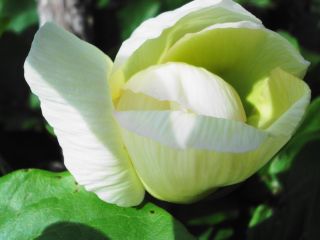
Paeonia sp., possibly Paeonia clusii
Photo by Marina Valli
After lunching on wild boar stifado in a rustic mountain taverna, we decided to forego the Galataki nunnery/garden at Limni and proceed straight to Candili, the Noel-Baker estate at Prokopi. No sooner did we sort out our rooms in the granary or stables (nicely converted, of course), than we found ourselves having drinks and mezedes on the lawn (a type of kikuyu grass, an African grass that doesn’t need much water, although water is plentiful in the area) while listening to Philip Noel-Baker’s lively and humorous account of the property’s history. This began when Annabelle Byron sent her cousin, Edward Noel, to find out the circumstances of her mad, bad husband’s death at Missolonghi. Edward, like his illustrious in-law, fell in love with Greece and bought the estate, then named Achmetaga, from the Ottoman pasha, and his descendants have held on to most of it, despite many ups and downs, since then.
In the morning, Philip gave us a tour of Candili’s serene gardens, which were designed by his grandmother and still have the structure she intended if not all the plants. In addition to a large vegetable patch, which feeds guests who come for weekends, workshops or retreats, the area around the house is divided into zones: a round garden demarcated with stones that once held wild strawberries and now has purple irises; a Japanese garden; a white garden; and Philip’s mother’s rockery. We were struck by the ginkgo tree – equivalent to the shark in the evolutionary ladder – an Acer palmatum (Japanese maple) with red, feathery leaves; English cherry trees (which prompted a spontaneous recitation of A E Housman’s ‘Loveliest of trees, the cherry now’ by one member), sculpted bay trees, a magnolia, medlars and various pools, one enclosed by bamboo, the other inhabited by vociferous frogs.
That day we set out from the house for walks into the adjacent forest and later to a picnic site, which involved crossing a river by Land Rover or wading. The following day, we had a cliff walk along the Aegean coast, with the crashing sea on one hand and masses of flowers on the other. The ground cover here and in the woods included orchids (Ophrys scolopax), Crepis rubra, stock (Malcolmia flexuosa), birthwort (Aristolochia rotunda), various members of the genus Anthemis, knapweed (Centaurea montana), broomrape (Orobanche sp.) and yellow and blue alkanets (Alkanna sartoriana and A. tinctoria, or dyers’ alkanet, named for the dye produced from its roots).
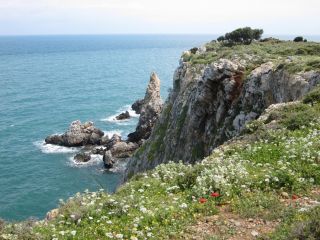
From our walk along the Aegean coast near Mantoudi,
carpets of flowers and the sea crashing beneath us
Photo by Olia Jakovides

An orchid, probably Ophrys scolopax
Photo by Olia Jakovides
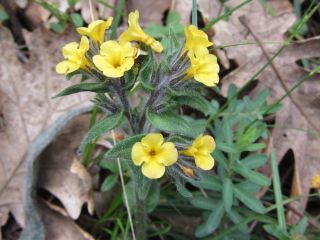
Alkanna sartoriana, endemic to southern Greece
Photo by Diana Farr Louis
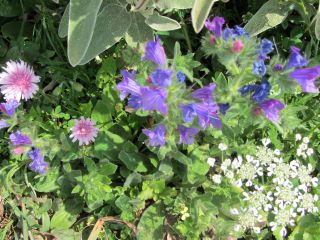
Crepis rubra and an echium
Photo by Diana Farr Louis
But quite apart from flowers, the presence of so many different types of magnificent trees all over this part of Evia gave a lift to our spirits. Their colours, ranging from nearly black to the lightest of greens and even reds, gladdened our eyes; their shade cooled our walks; their rustling leaves calmed our ears and minds. We left completely refreshed, blessed by the weather and the company of new and old friends.
Diana Farr Louis
March 2013
Visit to Tatoi, the former royal estate
On a warm sunny day in early March, dozens of Greek Branch members met at a back gate of what we used to call ‘The King’s Estate’ at Varibombi in the foothills of Mt Parnis. Although many of us know the property, this time we were treated to a guided tour given by Vassilis Koutsavlis, president of the Tatoi Friends Association, the NGO dedicated to protecting and restoring the 40 historic buildings and grounds.
Our four-hour ramble took us from the shell of the gardener’s cottage and other staff quarters in a state of advanced dilapidation to the royal ‘palace’ and overgrown gardens, the model farm buildings and, finally, the royal chapel and tombs. Along the way, Mr Koutsavlis told us the fascinating story of this huge – 41-square-kilometre - estate, whose sad neglect reflects successive Greek governments’ conflicting attitudes toward the monarchy’s role in the country’s history.
He made it very clear that the land never belonged to the State and that it was bought in 1872 by King George I, a Danish prince who assumed the throne in 1864, using his wife’s money. Grand Duchess Olga was a Romanov after all. After the referendum in 1974, in which the Greek people voted to abolish the monarchy, ownership of Tatoi was disputed for decades until 2002, when the European Court for Human Rights at Strasbourg declared the State should pay the ex-king (a minimum) compensation for taking it over. Since then, the royals have the right to visit their family graves, but the property belongs to ‘the Greek people’. (More history can be viewed at the Friends’ website in Greek and in English.)
So many years of abandonment have taken their toll on both the buildings and the surroundings. But Mr Koutsavlis painted a vivid picture of what the place must have been like. We were astonished to learn, for example, that what we thought was a venerable old forest, had in fact been planted – and landscaped – by George I, who had a precise plan (since lost) of trees chosen for their aesthetic, wind- or fire-protection qualities. He wanted above all to create a corner of Greece that would remind him of Denmark, and he was far more interested in nature than in architecture, rejecting Ernst Ziller’s original designs for an imposing palace.

View of the ‘palace’ through the overgrown south garden
Indeed, the royal residence today, called a palace by the Greeks, resembles a modest Northern European country mansion. Built after fire destroyed the first one in 1916, it is an exact model of the Peterhof palace in St Petersburg, and the management of this Russian palace are currently advising the Friends on restoration, which is about to begin (a previous restoration attempt having strayed far from the original). On the other hand, the farm buildings, many of them in good repair, look as though lifted straight from Denmark and are certainly more grandiose than any stables complex here.
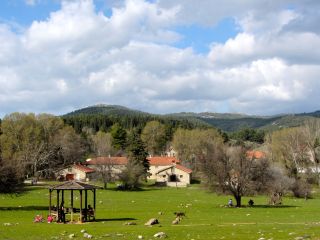
Some of the restored farm buildings, lifted straight from Denmark
Of the gardens little remains; we know that the one behind the residence was used for al fresco lunches and dinners – the palace being too small to accommodate grand parties – and you can still see outlines of the beds. The one in front, which faces south, consisted of three levels, the first two joined by graceful, curved staircases that lead to a pool and a grotto embellished with a lion’s head. We were told that all the plants were Greek, but nothing has been pruned since 1967 and the vegetation is a thick jungle by now, all but concealing the oldest tennis court in this country.
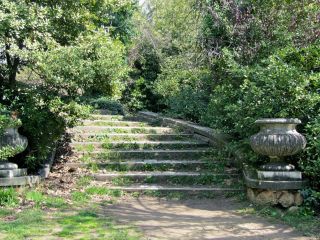
The still graceful staircase from the main residence to the
lower garden, fountain and tennis court
The trees, though, are magnificent: a circle of giant cypresses still exudes energy, others form a maze (now semi-obliterated by tree trunks and fallen branches). In addition to some heroic palms, we also noted bay, arbutus, photinia with its reddish leaves, an alley of sadly truncated poplars, Judas trees, lime and fruit trees, pines of all sorts, and enormous plane trees, many coping valiantly with vines. Wisteria, not yet in bloom, covered the north side of the palace almost completely. Olive trees abound, for the estate was self-supporting; besides oil and olives, it also produced resin from the pines, eggs and milk, and public funds were never used for its upkeep. The open, gently undulating hills to the northeast once supported vineyards that produced the royal wine, Château Dekelia, named after the Spartan fortress built here in the last phase of the Peloponnesian Wars in the 5th century BC.
Disappointingly, flowers were few and far between, but we did spy some earthstar fungus (Astraeus hygrometricus), looking eerily like Cyclops’ eye.
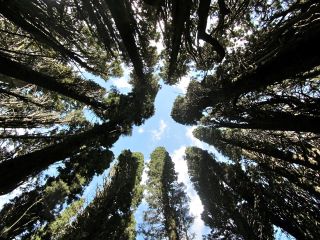
The cypress circle from below
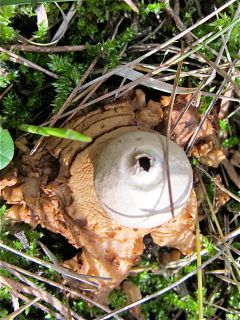
An earthstar fungus
We finished our tour at the chapel and royal cemetery, which was moving in its simplicity: unadorned marble slabs under the pines, carved with their occupants’ name and dates, in Greek and sometimes in Cyrillic, Danish, French, German, or English, if the prince or princess had been foreign-born.
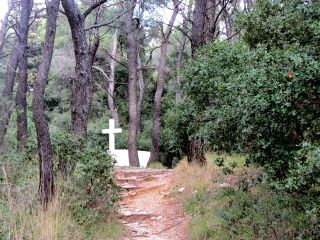
Shaded by pines, all the graves in the royal cemetery are very simple
Vassilis Koutsavlis gave this part of his talk in Greek, bringing to each life the same sympathy and deep historical knowledge that he had given the estate buildings and grounds. While our tour might have been of more cultural than horticultural interest, we felt privileged to have Mr Koutsavlis as our guide to this fascinating, extraordinary property. And when the Tatoi Friends are in a position to restore the gardens, we look forward to collaborating with them. We raised a small donation from our outing and thanks were posted on their website.
Text and photos by Diana Farr Louis
February 2013
Plant division and potting workshop
Seated in a circle on deck chairs, enjoying the perfect weather, a group of MGS members and some friends had gathered on the “threshing floor” at Sparoza for a workshop on dividing and potting plants conducted by Isabel Sanders. Isabel is studying Horticulture and Plantsmanship at the Royal Botanic Gardens Edinburgh, and she has taken a year off to gain practical experience working as a student gardener at Sparoza.
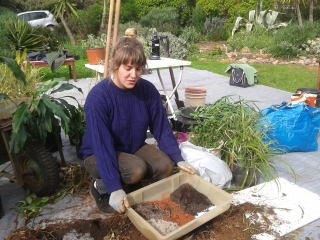
Isabel’s recommended mix for potting soil
Various plants had been brought by members, and others were from the Sparoza garden. Isabel had already prepared potting soil and she began by demonstrating how it was made. She noted that when dividing herbaceous and bulbous plants it is important to keep in mind the following:
- Always have the right tools to hand (secateurs/garden forks/knife).
- Prepare in advance soil and pots for potting up divisions.
- If divided plants are not going to be planted/potted up straight away, cover the roots or put them in a container to keep them from drying out.
- Plants are best divided when dormant (usually in late winter) so they can focus on growing their bottoms instead of their tops.
- When dividing plants be firm but gentle! Of course, when you use a knife to cut up woody or fleshy roots it is impossible to be gentle.
- Always re-plant divisions to the depth at which they were previously planted.

‘Props’ used for the demonstration
The plants used in the demonstration were:
Acanthus mollis. From its rhizomes it produces baby plants which have their own roots and can be broken off. Root cuttings can also be grown horizontally in a tray.
Agapanthus praecox ssp. orientalis. Produces baby plants from its rhizomes. To separate them, shake, bounce, pull apart and break the little woody connections. If you wash them clean of earth, they can be separated more easily.
Billbergia nutans. A bromeliad that can live out of doors in a sheltered spot. You can pull this one apart and cut the little woody connections with a knife if necessary. Flowers in early spring.
Bulbine frutescens. Native to southern Africa, this lily forms fibrous, low-spreading clumps, and produces air roots on the stems. The method used to separate these was tear, shake and pull apart.
Clivia miniata. Named after Lady Clive, granddaughter of the famous Clive of India. The one we practised on had pendulous orange flowers. This plant is surface-rooted and is said to dislike soil disturbance. The plants should be divided after flowering, but some that had been dug up two weeks earlier were happily flowering in an IKEA bag. We used a knife to cut these rather woody plants apart and discarded large quantities of roots before replanting.
Tulbaghia violacea. Known as Society Garlic, this plant does have a strong garlicky smell. It makes big clumps, is evergreen and needs to be divided frequently to keep it flowering. The method used was to shake, bounce, remove soil and pull apart. If you have too many of these plants, apparently you can eat the bulbs so they won’t go to waste. Flowers through spring and early summer.
Narcissus papyraceus. Narcissi need to be divided frequently if they are to flower. The bulbs tend to grow very deep in the soil, so be careful when you dig them up. Divide the plants and replant them up to where the green begins. Make sure to let the leaves dry up completely before you remove them in the summer. After flowering, these clumps are less unsightly if you braid or twist the leaves into a knot.
Ruellia simplex. A herbaceous plant which produces new shoots from its roots that can be pulled apart.
Salvia microphylla. Makes new shoots which can be split apart. Isabel demonstrated how to do this by inserting two garden forks, back to back, into the root ball and pulling them away from each other.
Coffee, tea and cakes were served after this informative and enjoyable demonstration was over.
Text and photos by Frosso Vassiliades
January 2013
An illustrated talk on the gardens of Adelaide and Melbourne
Alisdair Aird, who is well known in MGS circles as a leader of exciting trips in the Mediterranean, an expert in horticultural lore and a moderator of our Online Forum, treated a standing-room-only audience at Sparoza to a marvellous slide show of Australian gardens and flora. He and his wife, Helena Wiesner, attended the AGM in Adelaide last autumn and took part in every optional visit on offer, so we got a fleeting but extremely enjoyable taste of the meeting.
As a preamble, Alisdair told us, ‘My pix are a poor substitute for the wonderful gardens we saw there – at least 30! Our hosts treated us royally, they were very welcoming, and many have sponsored a plant at Sparoza and value their link to the Greek heart of the Society.’
He said that while the climates of both Melbourne and Adelaide resemble that of the Mediterranean, ‘Melbourne usually has some rain in most months of most summers, but both Adelaide and Adelaide are just beginning to recover from 12 years of severe drought’, as we know from the horrific fires that keep making headlines. As a result, almost all the gardeners took pains not to use more water than necessary.
As Alisdair showed us slide after slide, the audience hung on his every word as he mentioned not only the names of the plants we were viewing, but also the characters of the gardens and their owners, without missing a beat or stumbling over a syllable, barely consulting his notes.
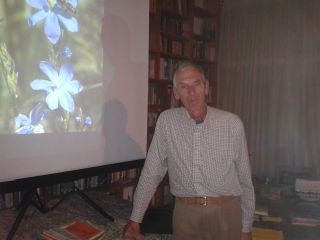
Alisdair Aird
Photo by Frosso Vassiliades
We learned that some gardeners insist on growing only native plants, while others have a mix of introduced and endemic ones, that dense planting and sometimes careful pruning seem to be the norm, reflecting an effort to mitigate cruel salty or arid winds and high temperatures (regularly over 43-44 °C), and that a feature typical of many gardens is interesting use of artefacts, pots, sculpture, and hard landscaping (walks and steps).
While some of the plants looked familiar, others looked otherworldly, as though from another planet or era. The first show-stopper was a grevillea, one of a big family (Proteaceae) of Southern Pacific plants, followed by a Doryanthes excelsa, or gymnea lilywith a spear about five metres tall surmounted by tufted red flowers, from the Melbourne Royal Botanic Garden. At their extensive new Cranbourne site, which specializes solely in native plants in their simulated natural environments, we saw a brand-new area typical of the arid interior. Another area boasted another oddity – grass trees (Xanthorrhoea johnsonii), with inflorescences jutting above them like poles. One of these very slow-growing marvels was 400 years old.
We saw acacias, not as trees, but as ground cover; explosions of Echium candicans ‘going mad’; more grevilleas with enormous flowers; and, at Lambley, a wonderful collection of plants introduced by early settlers who arrived in Australia via South Africa. It was here that Alisdair expanded on the ‘native Oz movement that is trying to weed these intruders out’, even though they have adapted to local conditions and include forms no longer found even in their own South Africa. Some garden centres sell only natives.
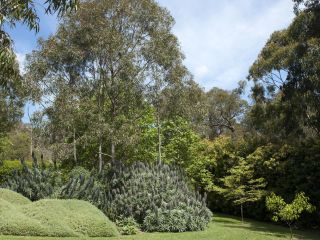
Echium candicans
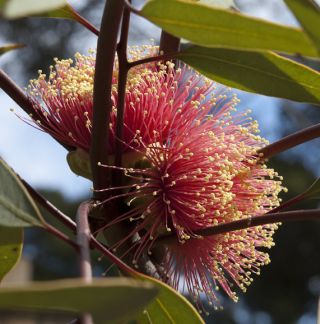
Eucalyptus youngiana
Being in Australia, of course Alisdair came across many types of eucalyptus, including red gums, known as ‘widow makers’, because they have a tendency to shed their branches on unwary husbands. Others, unknown in Greece at least, had showy flowers. Further wonders included a thickly-flowered ‘Crépuscule’ rose from Tipsy Hill, a surreal-looking Beaucarnea from the Adelaide Botanic Garden, a ‘native frangipani’ (Hymenosporum flavum) with fragrant, soft golden yellow blooms at the Waite Arboretum, and a huge, bushy caper tree (!), Capparis mitchellii, which towered over people. Apparently it does bear fruits (like our tough cliff-hanging capers), which are appreciated by the Aboriginal people.

Beaucarnia stricta
In the Adelaide hills, where the climate is more temperate, we had a glimpse of Trevor Nottle’s garden, which consisted almost entirely of introduced plants, including an amazing array of interesting cultivars collected from all over the world. The Barossa Bushgardens were the opposite, a community garden set up to propagate local plants. It was organized so efficiently that it employed only one paid propagator; volunteers handle the rest of the work. Following that, Alisdair visited three other widely differing private gardens: one with entertaining artworks and new plantings rejuvenating a fifth-generation property; one shaded by an awesomely humongous Ficus macrophylla (which amply repaid the cost of two bathroom rebuilds caused by its thirsty roots); and one with ample borehole water providing a wonderful fantasy re-creation of a large romantic English country garden.

Ficus macrophylla
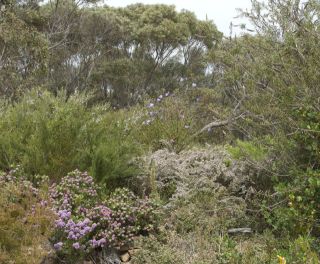
Stokes Bay Bush Garden
The show ended with the programme’s optional trip to Kangaroo Island – 20 per cent bigger than Evia – which included Stokes Bay Bush Garden's stunning range of native plants. Then out in the wild, remarkable flowers and the ‘Remarkable Rocks’ (giant boulders on a volcanic outcrop) gave way to remarkable animals: a family of blasé sea lions basking on white sand.
It was a show we could have watched for much longer, but Alisdair’s delightful presentation was certainly the next best thing to being there.
See also Alisdair’s article in TMG 71, January 2013, and for more photos, see here.
Diana Farr Louis
Photos by Alisdair Aird |


